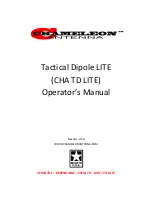
CHA TD LITE
Page 13
11.
Using a Bowline or similar knot, tie another long
length of Paracord to the Isolation Loop (c) at
the free end of the Antenna Wire.
12.
Using a throw weight or some other method,
loop the Paracord over the other support.
13.
Raise the free end of the Antenna Wire to a
height of 10 to 12 feet, such that the Antenna
Wire is not quite taut, and secure it to the
support using a Round Turn and two Half
Hitches, or similar knot.
Extend the Counterpoise.
14.
Extend the counterpoise Antenna Wire from
step (4) along the ground under the raised
horizontal section of the antenna.
15.
Perform operational test.
Recovery Procedure
To recover the CHA TD LITE, perform the following steps:
1.
Disconnect the Coaxial Cable from the radio set.
2.
Lower the antenna to the ground.
3.
Disconnect the Coaxial Cable from the Matching Transformer (a).
4.
Carefully roll (do not twist) the Coaxial Cable.
5.
Untie the Paracord from the Matching Transformer and Antenna Wires (b), as applicable.
6.
Disconnect the Antenna Wires from the Matching Transformer.
7.
Wind the Antenna Wires onto their Line Winders (e) and secure with attached shock cord.
8.
Pull the Stakes (f) from the ground.
9.
Remove dirt from antenna components and inspect them for signs of wear.
Troubleshooting
1.
Ensure Wire Connectors (k) are securely connected.
2.
Inspect Antenna Wires (b) for breakage or signs of strain.
3.
Ensure UHF Plugs are securely tightened.
4.
Inspect Coaxial Cable assembly for cuts in insulation or exposed shielding. Replace if damaged.
5.
If still not operational, connect a Standing Wave Ratio (SWR) Power Meter and check SWR.
6.
If SWR is greater than 10:1, check antenna tuner or coupler using the technical manual or
manufacturer’
s
procedure. Be sure to check the Coaxial Patch Cable that connects the radio set to the antenna tuner or
coupler.
7.
If still not operational, replace Coaxial Cable assembly.
Most problems with antenna systems are caused by
the coaxial cables and connectors.
8.
Connect a Multi-Meter to the Antenna Wires to check continuity. Replace assemblies that do not pass a
continuity check.
9.
If still not operational, replace Matching Transformer (a).
Specifications
•
Frequency: 1.8 MHz through 54.0 MHz continuous (including all Amateur Radio Service bands 160m to
6m). Wide range antenna tuner or coupler required.
•
Power: 250 W continuous duty cycle (CW, AM, FM, RTTY), 500 W intermittent duty cycle (SSB and SSB-
based digital modes)




































